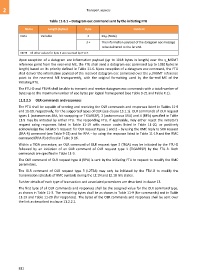Page 822 - 5G Basics - Core Network Aspects
P. 822
2 Transport aspects
Table 11-8.1 – Datagram eoc command sent by the initiating FTU
Name Length (bytes) Byte Content
Data Variable 2 0116 (Note)
3 + The information payload of the datagram eoc message
to be delivered to the far end.
NOTE – All other values for byte 2 are reserved by ITU-T.
Upon reception of a datagram eoc information payload (up to 1018 bytes in length) over the γ_MGMT
reference point from the near-end ME, the FTU shall send a datagram eoc command (up to 1020 bytes in
length) based on its priority defined in Table 11-6. Upon reception of a datagram eoc command, the FTU
shall deliver the information payload of the received datagram eoc command over the γ_MGMT reference
point to the near-end ME transparently, with the original formatting used by the far-end ME of the
initiating FTU.
The FTU-O and FTU-R shall be able to transmit and receive datagram eoc commands with a total number of
bytes up to the maximum number of eoc bytes per logical frame period (see Table 9-21 and Table X.1).
11.2.2.5 OLR commands and responses
The FTU shall be capable of sending and receiving the OLR commands and responses listed in Tables 11-9
and 11-10, respectively, for the supported types of OLR (see clause 13.1.1). OLR commands of OLR request
types 1 (autonomous SRA, bit swapping or TIGARESP), 2 (autonomous SRA) and 4 (RPA) specified in Table
11-9 may be initiated by either FTU. The responding FTU, if applicable, may either reject the initiator's
request using responses listed in Table 11-19 with reason codes listed in Table 11-20, or positively
acknowledge the initiator's request: for OLR request types 1 and 2 – by using the RMC reply to SRA request
(SRA-R) command (see Table 9-15) and for RPA – by using the response listed in Table 11-19 and the RMC
command (RPA-R) defined in Table 9-16.
Within a TIGA procedure, an OLR command of OLR request type 3 (TIGA) may be initiated by the FTU-O
followed by an initiation of an OLR command of OLR request type 1 (TIGARESP) by the FTU-R. Both
commands are specified in Table 11-9.
The OLR command of OLR request type 4 (RPA) is sent by the initiating FTU to request to modify the RMC
parameters.
The OLR command of OLR request type 5 (L2TSA) may only be initiated by the FTU-O to modify the
transmission schedule of RMC symbols during the L2.1N and L2.1B link states.
Further details of each type of transaction and associated procedures are described in clause 13.
The first byte of all OLR commands and responses shall be the assigned value for the OLR command type,
as shown in Table 11-3. The remaining bytes shall be as shown in Table 11-9 (for commands) and in Table
11-19 and Table 11-20 (for responses). The bytes of the OLR commands and responses shall be sent over
the link as described in clause 11.2.2.1.
812

